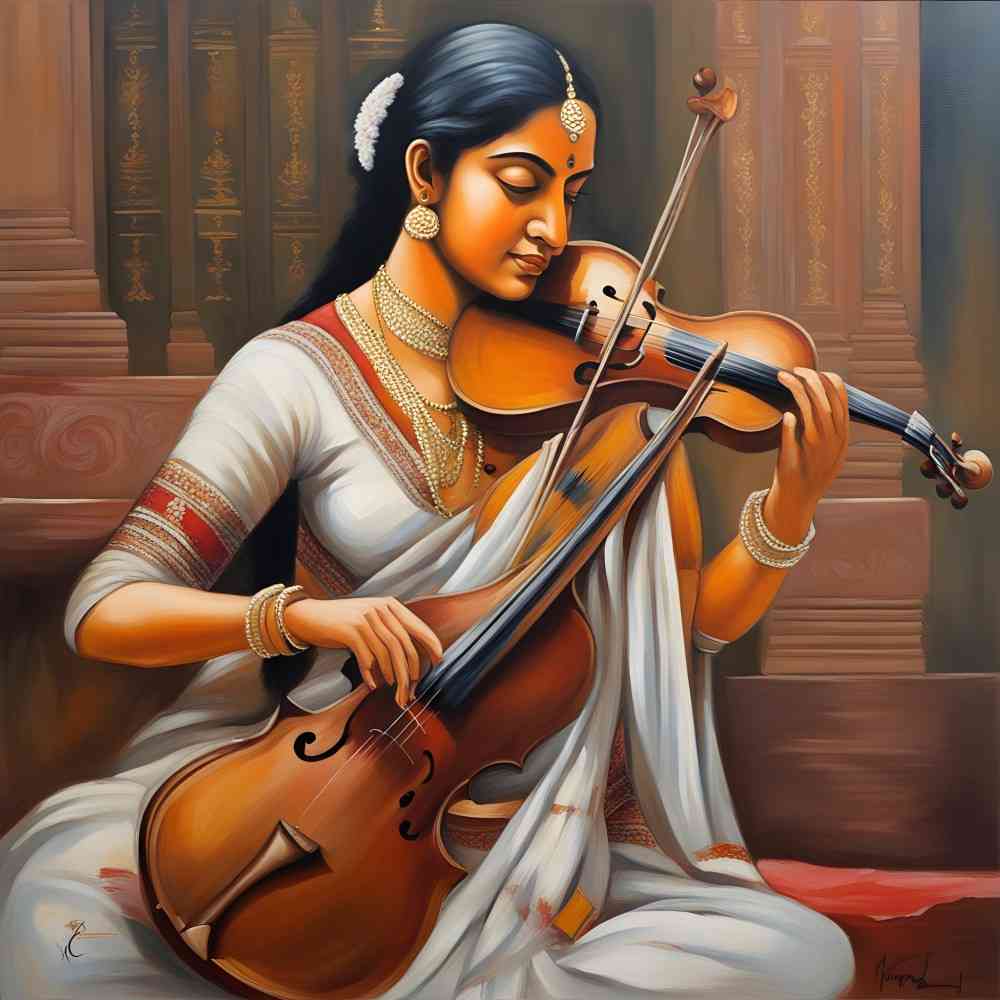The history of Indian music is an awe-inspiring narrative that unfolds across thousands of years. It intricately weaves together a myriad of influences, regional nuances, and profound developments. In this article, we will embark on a captivating voyage through time to unravel the story of Indian music’s evolution tracing its origins from ancient times to its vibrant contemporary expressions.
Ancient Origins
The history begins in the Vedic era, which spans about from 1500 BCE to 500 BCE. This time in history is characterized by the production of the Vedas. This is thought to be the first Hindu scriptures. These texts laid the fundamental tenets that still influence classical Indian music today. They serve as the cradle from which Indian music originated.
Within the Vedas, hymns and chants dedicated to various deities were not just expressions of devotion. They were integral components of rituals and ceremonies. These sacred compositions, accompanied by musical elements, created an early form of music therapy. They invoked divine blessings while offering spiritual and artistic solace. Simple musical instruments like flutes and drums were used to complement the melodic and rhythmic parts of these hymns. This created a profound combination of sound and spirituality.
One of the most important and long-lasting contributions of the Vedic period to Indian music was the establishment of fundamental concepts like ragas (melodic modes) and talas (rhythmic cycles). Now, they form the foundation of traditional Indian music and preserve the spirit of an ancient tradition.
Dynastic Influences
The history of Indian music bears the imprints of various dynasties that have ruled over the subcontinent. Dynasties like the Mauryan, Gupta, Chola, and others played pivotal roles in nurturing and promoting this art form. The patronage of rulers gave birth to regional music styles. Each of them reflected the cultural ethos of its time.
The Mauryan Dynasty
The Mauryan Dynasty flourished from the 4th to the 2nd century BCE. It stands as one of ancient India’s earliest empires. Emperor Ashoka’s patronage of the arts marked a significant period for the flourishing of Indian music. Music and dance occupied an integral place in the Mauryan court. Musicians and dancers enjoyed a privileged status.
During this era, classical music experienced refinement, and musical theories were codified. Music was not just a form of entertainment; it was a conduit for spiritual expression. The Mauryan period laid the foundation for essential musical concepts. This has shaped Indian music for generations.
The Gupta Empire
The Gupta Dynasty, spanned from the 4th to the 6th century CE. It is celebrated as the “Golden Age” of Indian history, marked by artistic and cultural zenith. Under Gupta rulers, classical music and dance reached unprecedented heights of refinement and sophistication.
During this age, treatises on music and dance flourished. Scholars like Matanga and Dattilam made substantial contributions to musical theory. This provided intricate guidelines for the performance and composition of classical music. This period set the stage for the emergence of diverse regional music styles in the ensuing centuries.
The Chola Dynasty
The Chola Dynasty reigned over South India from the 9th to the 13th century CE. It left an indelible mark on the development of Carnatic music, the classical music tradition of South India. The Chola rulers ardently supported the arts. They provided substantial patronage to musicians and artists.
Carnatic music evolved and gained structure during the Chola period. It was during this time that the concepts of “ragam” (melodic framework) and “talam” (rhythmic framework) were formalized. Additionally, the Cholas established temple orchestras, where music was played. It was an indispensable role in religious rituals.
Other Dynasties and Regional Styles
India’s history is replete with various dynasties, including the Rashtrakutas, Pallavas, and the Vijayanagara Empire. Each contributed significantly to the nurturing and promotion of music. These dynasties provided platforms for musicians to showcase their talents. They fostered regional music styles that were influenced by local traditions and customs.
Medieval Marvels
The medieval period witnessed an extraordinary fusion of Indian and Persian musical traditions. This was under the Mughal Empire. The era marked the zenith of classical music, with legendary musicians such as Tansen and Baiju Bawra gracing royal courts. The iconic Indian instrument, the sitar, saw significant development during this period.
Sufi music also left an indelible mark during medieval times. Qawwalis and ghazals became integral parts of Indian musical heritage. The soul-stirring compositions and spiritual messages of Sufi saints transcended religious boundaries. This fostered harmony through the medium of music.
Colonial Influences and Modernity
The British colonial era, spanning nearly two centuries, wielded a profound impact on Indian music. New musical instruments and Western musical genres were among the important contributions made. Indian music evolved as a result of a cross-cultural interchange that was facilitated by British colonial rulers and their encounters with Indian artists.
During this period, Indian musicians began experimenting with Western Musical Elements. It then gave birth to the genre of Indo-Western fusion. This fusion seamlessly melded traditional Indian Musical Instruments, melodies, and rhythms with Western harmonies and orchestration. It further birthed entirely new forms of music that resonated with audiences both in India and the Western world. Renowned musicians like Ravi Shankar and Zakir Hussain played pivotal roles in pioneering this fusion movement. They crafted mesmerizing compositions that resonated globally.
In addition to Indo-Western fusion, this era saw the emergence of other fusion genres. Such as jazz-fusion, which blended the improvisational nature of jazz with classical Indian music. Musicians like John McLaughlin and Shakti brought these genres to the forefront. This showcased the versatility and adaptability of Indian music in a modern context.
Post-Independence Renaissance
The year 1947 marked a pivotal turning point in Indian history as the nation gained independence from British colonial rule. This newfound freedom ignited a cultural renaissance. The government actively supported the preservation and promotion of traditional Indian music. There was a renewed emphasis on reviving classical music forms and preserving the rich heritage of Indian musical traditions.
During this era, several Indian musicians garnered international acclaim. With this, they transcended boundaries and introduced the world to the enchanting melodies of Indian music. Legends like Lata Mangeshkar, renowned for her soul-stirring playback singing in Indian cinema. Also A.R. Rahman, who seamlessly blended traditional Indian music with contemporary sounds, became global icons. Their contributions showcased the depth and diversity of the Indian music scene on the world stage.
The All India Radio (AIR) played a pivotal role in disseminating classical music to the masses. They Served as a bridge between classical music maestros and the general public. AIR broadcasted classical concerts, music lessons, and informative programs. This democratization of access to classical music helped preserve. It also nurtured the tradition for future generations.
The Digital Age
Indian music is still evolving and adapting in the digital age, with a focus on fusion and experimentation in particular. By fusing aspects from the past and the present, composers and musicians build new worlds. Bollywood music, for instance, combines a variety of sounds such as electronic beats and ancient ragas. They produce a wide range of enticing compositions that captivate listeners all over the world.
Thanks to the internet and digital media, music creation has become more accessible. The platforms and resources accessible to independent musicians today have helped to create a strong independent music scene in India. These musicians push the limits of musical expression. They experiment with novel sounds and challenging norms.
The growth of Indian music’s popularity has been boosted by websites like YouTube and streaming services. Indian music of all genres—traditional, modern, and fusion—can now be easily found. They can also be appreciated by a large audience on a global scale. This has improved the worldwide music scene by increasing the exposure of Indian music. And also the possibility of intercultural partnerships.
Final Thoughts
The development of Indian music is evidence of its tenacity and adaptability. It has subtly assimilated elements from other cultures and times while still being firmly rooted in its valued traditions. The sacred chanting of the Vedas to the broad appeal of Bollywood melodies—all are part of the remarkable history of Indian music, which is a story of creativity, passion, and cultural legacy. As it progresses, it promises to hold audiences around the globe spellbound for many years to come.

